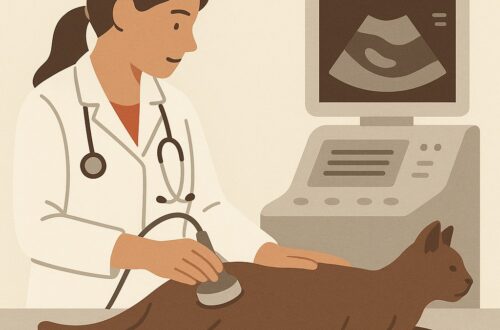The airway is a complicated system that can be affected by many different problems, including pneumonia and asthma. A common problem in younger cats is nasopharyngeal polyps. This week I share information about this disease that can dramatically and negatively affect quality of life. Happy reading!

Nasopharyngeal Polyps – What Are They?
To understand the nature of nasopharyngeal polyps, one must have a basic familiarity with the anatomy of the throat and ears of cats. A normal cat ear is divided into three basic parts: the outer ear, the middle ear, and the inner ear. The middle ear is connected to the nasopharynx – the back of throat – via a special tube called the auditory or Eustacian tube.

Nasopharyngeal polyps often arise from tissue in the middle ear and then grow to travel down the Eustacian tube to ultimately protrude into the nasopharynx. Occasionally, nasopharyngeal polyps arise from the auditory tube. The cause of nasopharyngeal polyps isn’t truly known at this time. However, we believe they are the result of an adverse reaction to various infectious agents like respiratory viruses (i.e.: feline herpesvirus).
Nasopharyngeal Polyps – What Do They Look Like?
Both dogs and cats can develop nasopharyngeal polyps. However, disease occurrence in cats is much more prevalent. Felines of any age can develop clinical signs, but they are most commonly seen in pediatric patients and young adults. Clinical signs may initially be intermittent and very mild while the polyp is still small. However, as it grows to occupy more space in the nasopharynx, clinical signs become much more apparent and include:
- Sneezing
- Head shaking
- Nasal congestion
- Nasal discharge
- Gagging
- Difficulty swallowing
- Change in voice
- Abnormal and/or difficulty breathing
The nasopharynx is separated from the mouth by the soft palate. As a polyp grows, it pushes the soft palate downward to interfere with swallowing. Occasionally, a nasopharyngeal polyp will grow outward through the outer ear. This happens much more commonly in dogs, and affected patients develop clinical signs similar to those with otitis externa.
Nasopharyngeal Polyps – How Are They Diagnosed?
Cats with a medical history and clinical signs consistent with a nasopharyngeal polyp will need to be sedated for an oral and aural (ear) examination to confirm the presence of a polyp. Often nasopharyngeal polyps can be palpated above the soft palate, and they can be easily visualized with gentle retraction of the soft palate. Occasionally, computed tomography (CT scan) is recommended to determine the complete extent of a nasopharyngeal polyp.
Nasopharyngeal Polyps – How Are They Treated?
Nasopharyngeal polyps are commonly removed by gently applying traction to them (see video below). Unfortunately, this method has a relatively high rate of recurrence, and thus the true benefit of the traction technique is questionable. Many board-certified veterinary surgery specialists recommend a surgery called a bulla osteotomy if the middle ear is involved. Certainly if a polyp recurs following traction avulsion, a bulla osteotomy is always recommended to allow for complete removal of the origin of the polyp.
The take-away message about nasopharyngeal polyps in cats…
Nasopharyngeal polyps develop in cats most commonly after exposure to various infectious agents. Affected patients have a variety of clinical signs, most notably sneezing, nasal discharge, and difficulty swallowing. Surgical techniques are available to effectively remove them.
To find a board-certified veterinary surgeon, please visit the American College of Veterinary Surgeons.
Wishing you wet-nosed kisses,
CriticalCareDVM









How old is the cat with NP in the video? Does not look ‘young’?
Thanks for your message. Although he may not look young, the kitty in the video was ~1.5 years of age when the video was recorded.